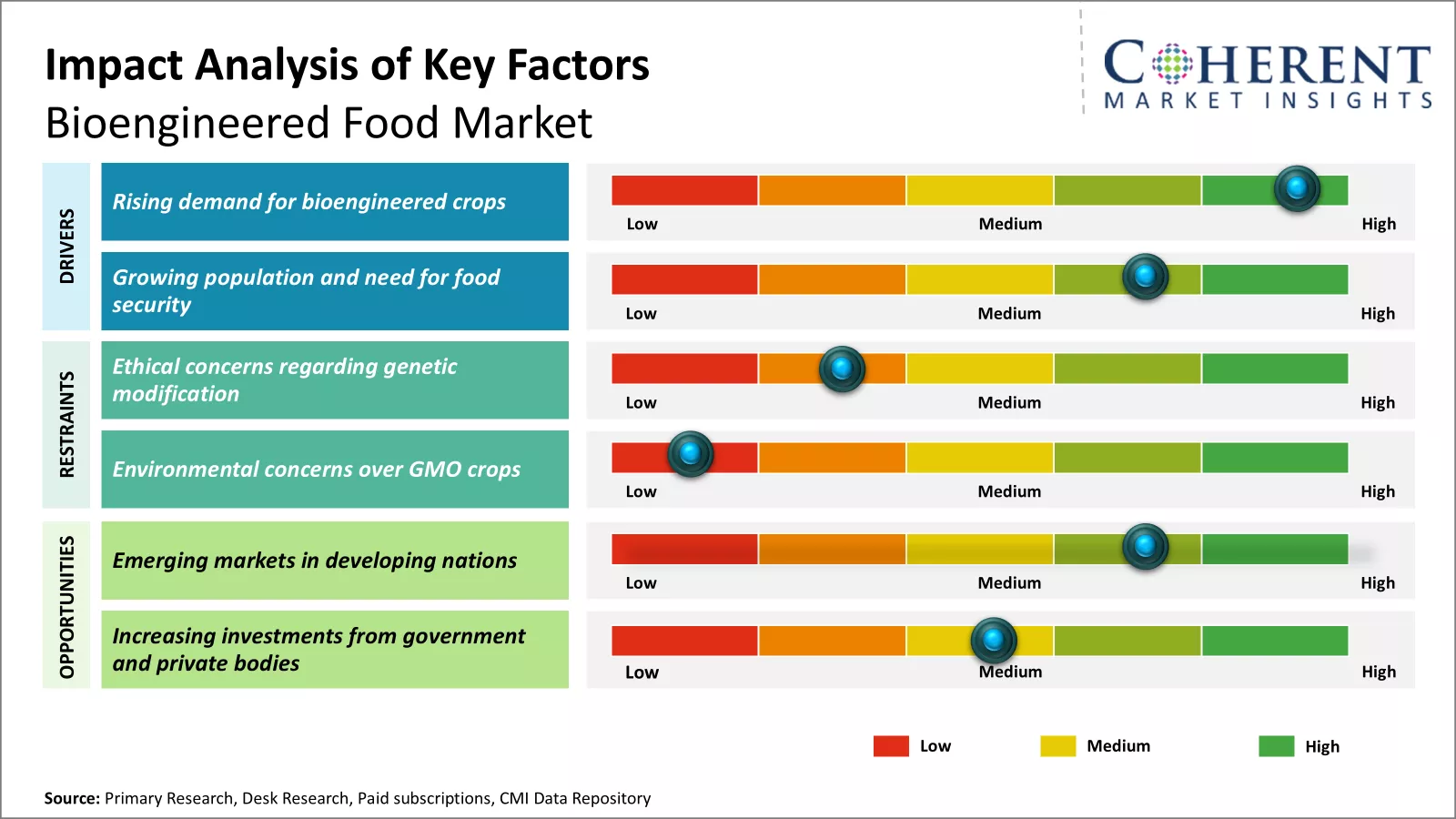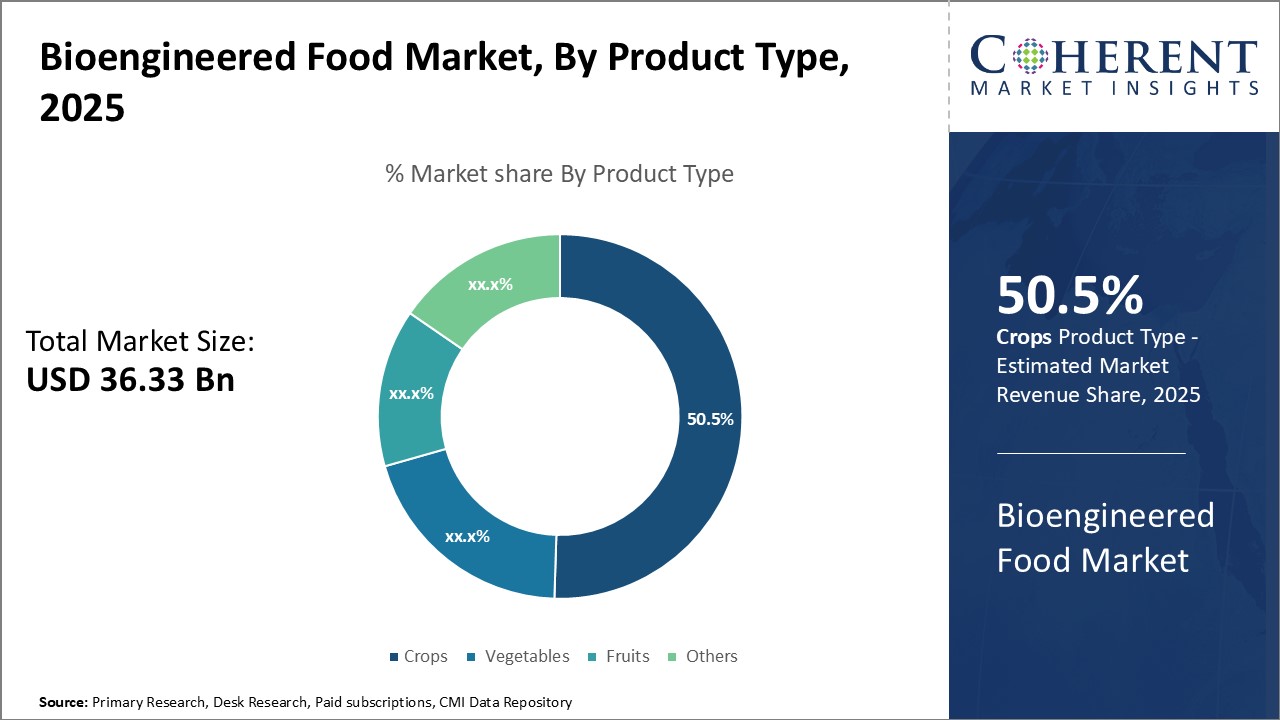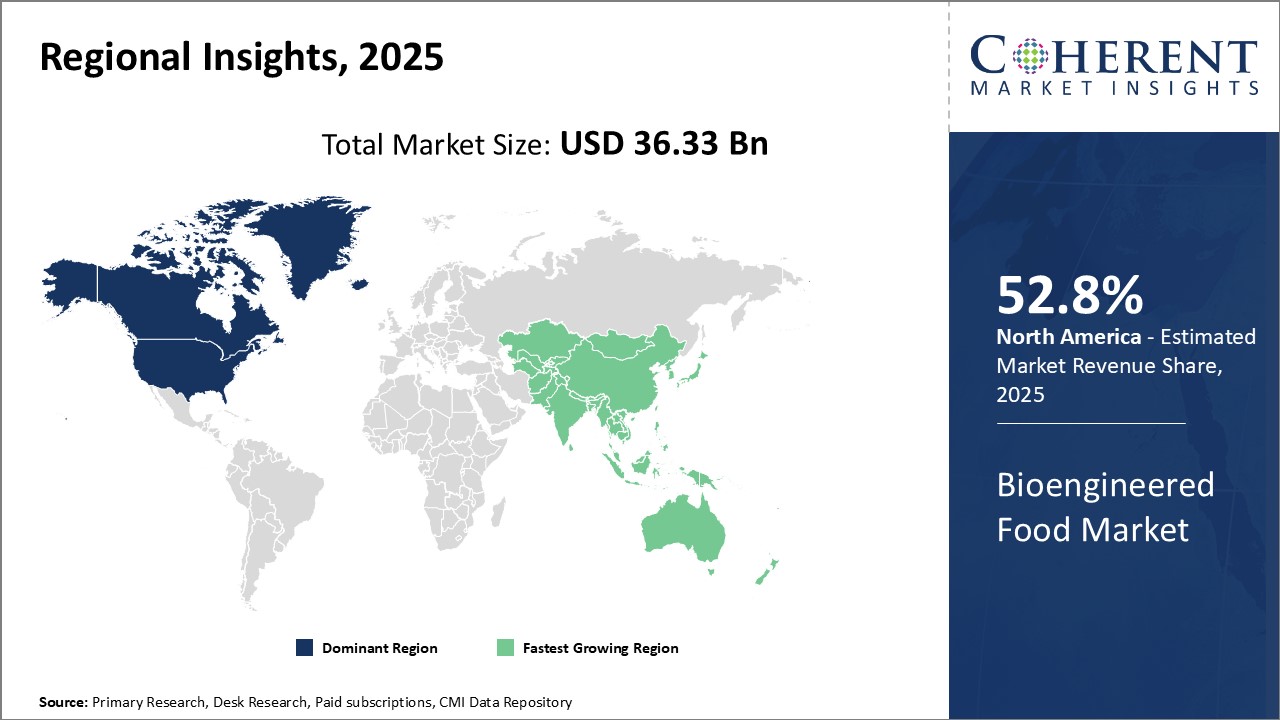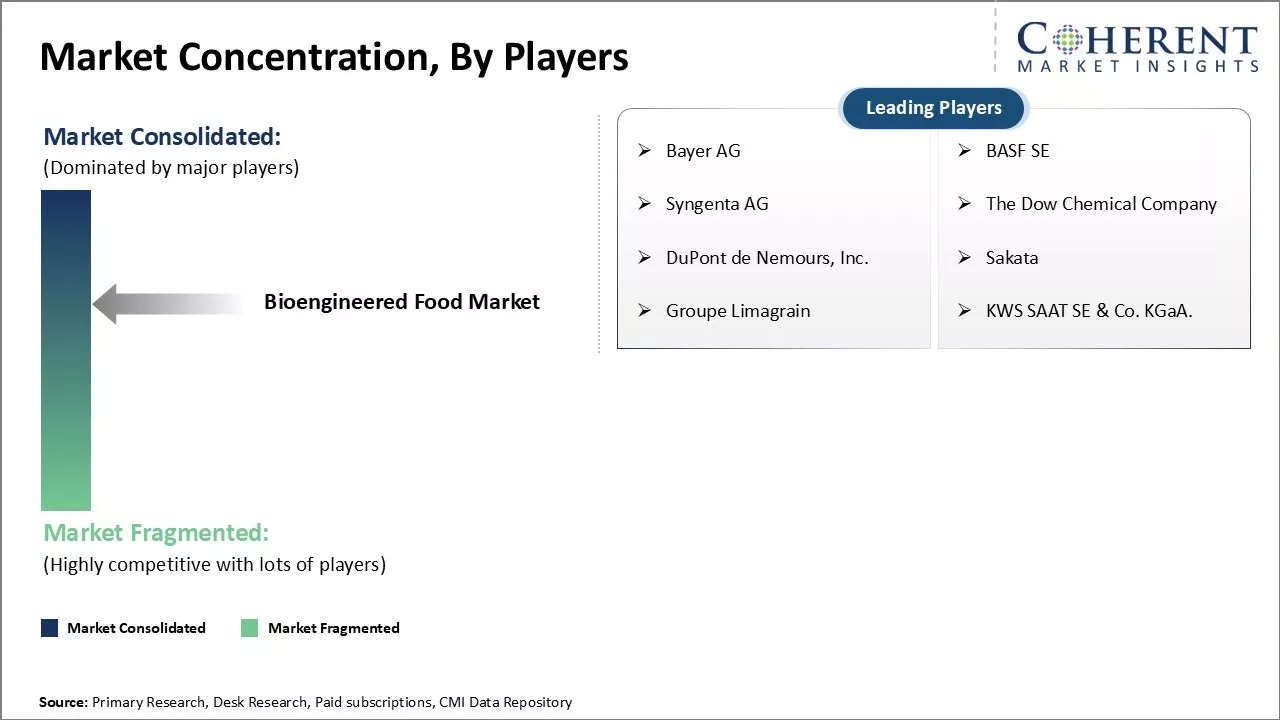The bioengineered food market is estimated to be valued at USD 36.33 Bn in 2025 and is expected to reach USD 52.19 Bn by 2032, exhibiting a compound annual growth rate (CAGR) of 5.3% from 2025 to 2032.

Discover market dynamics shaping the industry: Download Free Sample
Various technologies including genomic tools are being employed by companies to develop foods with improved qualities like enhanced vitamins and protein content. Growing investments in agricultural biotechnology as well as product innovation in genetically modified crops will further propel the market expansion during the forecast period. Increasing cultivation of biofortified varieties to address malnutrition issues globally is another key factor driving the uptake of biotech crops. However, consumer concerns around biosafety and ethical considerations may hamper the market growth to some extent.

Discover high revenue pocket segments and roadmap to it: Download Free Sample
Insights, By Product Type: Crops segment Contributes the highest market share owing to demand for higher yields and climate resilience
In terms of product type, crops segment is expected to hold 50.5% share of the market share in 2025. The crops segment within the bioengineered food market holds the largest share due to strong demand from farmers seeking higher crop yields and climate resilience. Farmers around the world continue adopting bioengineered or genetically modified (GM) seed varieties of major crops like corn, soybean and cotton due to proven benefits over traditional varieties. GM seed traits that enable crops to resist pests, diseases and herbicides allow farmers to significantly increase their per acre crop yields with fewer inputs.
Insights, By End User: Households segment contributes the highest market share driven by consumer preference for quality and affordability
The households’ segment is estimated to hold 38% share in 2025 of the end user segments within the bioengineered food market. As the global population swells, demand for affordable and nutritious food from households continues growing significantly. Bioengineered crops and food ingredients allow manufacturers to develop products that meet evolving consumer needs for better quality at low costs. Food products containing GM ingredients thus appeal widely to household budgets globally. Consumer research also increasingly shows acceptance and positive perceptions around the food safety and quality attributes of many bioengineered food items.
Regional Analysis: Bioengineered Food Market
Dominating Region: North America
North America is expected to account for the greatest revenue share of 52.8% in 2025. North America’s dominance in the bioengineered food market can be attributed to factors such as supportive government policies, presence of major industry players, and increasing awareness among consumers regarding nutritional benefits of bioengineered foods. Countries like the U.S. and Canada have established regulatory frameworks to promote research and development in biotechnology. Leading companies such as Monsanto and DuPont have also driven innovations through new product launches.
Fastest-Growing Region: Asia Pacific
The Asia Pacific region exhibits the fastest growth, led by countries like China, India and Japan. Rapid economic development, growing health consciousness, and rising disposable incomes have fueled demand for healthy and nutritious food options. National programs focusing on food security as well as partnerships between local farmers and international brands have contributed to the expansion of bioengineered crops.

Need a Different Region or Segment? Download Free Sample
Bioengineered Food Market Outlook for Key Countries
U.S.: The U.S. market dominates due to high R&D investments and adoption of latest technologies by agribusinesses. Companies like Monsanto and Corteva Agriscience develop new seeds tailored for the regional conditions.
China: The China market is growing steadily with government schemes promoting biotechnology in agriculture. Homegrown firms such as Bejo and Origin have increased availability of innovative products.
India: India continues to lead in the cultivation of Bt cotton. However, efforts are ongoing to introduce other genetically modified crops suitable for the local agro-climatic zones.
Japan: Japanese consumers have shown preference for traceable and locally grown bioengineered items. Major players including Meiji and Morinaga leverage this trend through focused marketing strategies.
Brazil: Brazil market is expanding on the back of suitable climatic conditions and supportive regulations. Groups like Brasmax and Biotrigo cater to rising farm-level demand.

Get actionable strategies to beat competition: Download Free Sample
Top Strategies Followed by Bioengineered Food Market Players
Emerging Startups in the Bioengineered Food Market
Several startups are developing innovative technologies to disrupt the industry. Companies like Indigo AG and Deep Branch Biotechnology apply techniques like molecular markers and transcriptomics for rapid plant breeding. Startups such as NotCo and Impossible Foods utilize AI, food science, and plant-based formulations to develop alt-meats and dairy substitutes. Their research into plant-based and cultivated meat alternatives could dramatically shift market dynamics over the coming decade.
Sustainability focused startups also show promise. Firms like Better Nature and Air Protein produce mycoprotein-based food from Non-Genetically Modified Organism (non-GMO) fungi and microbes as alternatives to livestock. They aim to offer nutritious foods with significantly lower emissions. Meanwhile, companies like Sylvatex and Evogene harness computational genetics tools to accelerate plant varieties resilient to drought, floods, and disease without transgenic modification techniques. Their sustainable solutions could support smaller farmers globally.
Many startups partner with other players to complement strengths. Collaboration supports strategic innovation and niche market opportunities. For example, Indigo AG works with farmers, seed producers, commodity traders, and policymakers worldwide to scale regenerative practices.
Key Takeaways from Analyst
Bioengineered Food Market Report Coverage
| Report Coverage | Details | ||
|---|---|---|---|
| Base Year: | 2024 | Market Size in 2025: | USD 36.33 Bn |
| Historical Data for: | 2020 To 2024 | Forecast Period: | 2025 To 2032 |
| Forecast Period 2025 to 2032 CAGR: | 5.3% | 2032 Value Projection: | USD 52.19 Bn |
| Geographies covered: |
|
||
| Segments covered: |
|
||
| Companies covered: |
Bayer AG, BASF SE, Syngenta AG, The Dow Chemical Company, DuPont de Nemours, Inc., Sakata, Groupe Limagrain, and KWS SAAT SE & Co. KGaA. |
||
| Growth Drivers: |
|
||
| Restraints & Challenges: |
|
||
Uncover macros and micros vetted on 75+ parameters: Get instant access to report
Market Driver - Rising demand for bioengineered crops
The demand for bioengineered crops is growing steadily across major markets due to their advantages over traditional crops. Farmers are adopting genetically modified crops that are resistant to pests and tolerant to herbicides as they result in higher yields and lower production costs. Consumers are also more accepting of bioengineered foods nowadays given their convenience and lower prices. In 2020, as per data from the United Nations Food and Agriculture Organization, over 190 million hectares of biotech crops were cultivated globally in 2020, a rise of 2 million hectares from the previous year. Countries like the U.S., Brazil, Argentina, India, Canada, and South Africa dominate biotech crop production worldwide. This rising cultivation of GM crops directly translates to higher availability of bioengineered foods.
This has resulted in increased crop yields and farm incomes for smallholder farmers. With growing acceptance of benefits, area under bioengineered soybean, corn, cotton is expanding steadily not just in developing nations but developed countries as well. Rising crop insurance claims due to unpredictable weather patterns is also supporting shift towards bioengineered resilient seeds.
Market Challenge - Ethical concerns regarding genetic modification
Ethical concerns surrounding genetic modification is indeed restraining the growth of bioengineered food market. While genetic engineering aims to improve crop yields, nutrition and resilience, there are legitimate worries about its long-term impact on environment and human health. The uncertainty around newly introduced transgenic traits and living organisms has raised sustainability and precautionary issues.
Another concern is the increased use of herbicides due to proliferation of herbicide-tolerant crops. As per a report published by Environmental Protection Agency in 2022, use of glyphosate, the primary ingredient in Roundup herbicide, increased more than 250 million pounds between 1996 and 2016 to match the expansion of GMO crops engineered to tolerate it. Overreliance on certain herbicides for weed management is diminishing the food system's resilience to weeds and impacting farmland biodiversity. It is also linked to health issues like cancer according to some research findings.
Market Opportunity - Emerging markets in developing nations
The global bioengineered food market has a major growth opportunity in the emerging markets of developing nations. While developed regions like North America and Europe currently dominate the bioengineered food landscape, several developing and under-penetrated markets still offer vast untapped potential. Countries like China, India, Brazil, Argentina, South Africa etc. are expected to drive future market growth. These developing economies are experiencing robust economic development, rising disposable incomes, and westernization of diets which is increasing the demand for food products. As per the UNICEF data from 2020, around 190 million children under 5 years of age suffer from vitamin A deficiency globally. Cultivation of golden rice especially in parts of Africa and Asia where deficiencies are widespread can potentially help address this.
Share
Share
About Author
Yash Doshi is a Senior Management Consultant. He has 12+ years of experience in conducting research and handling consulting projects across verticals in APAC, EMEA, and the Americas.
He brings strong acumen in helping chemical companies navigate complex challenges and identify growth opportunities. He has deep expertise across the chemicals value chain, including commodity, specialty and fine chemicals, plastics and polymers, and petrochemicals. Yash is a sought-after speaker at industry conferences and contributes to various publications on topics related commodity, specialty and fine chemicals, plastics and polymers, and petrochemicals.
Missing comfort of reading report in your local language? Find your preferred language :
Transform your Strategy with Exclusive Trending Reports :
Frequently Asked Questions
Joining thousands of companies around the world committed to making the Excellent Business Solutions.
View All Our Clients